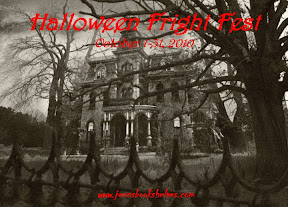I’m excited to welcome Mary Sharatt, author of Daughters of the Witching Hill, back for a special Halloween guest post. You may recall, I reviewed her book back in April and was pleased when she expressed an interested in participating in Fright Fest.
Killing a Witch: Magical Warfare in 19th Century Lancashire by Mary Sharratt
 Modern Halloween celebrations, with their cartoon witches on broomsticks, belie the fact that our not-so-distant ancestors believed that magic was real, and not always in a good way. People lived in dread of vast teeming invisible forces threatening their very existence and they were all too willing to blame their misfortunes on supposed witches.
Modern Halloween celebrations, with their cartoon witches on broomsticks, belie the fact that our not-so-distant ancestors believed that magic was real, and not always in a good way. People lived in dread of vast teeming invisible forces threatening their very existence and they were all too willing to blame their misfortunes on supposed witches.
My adopted home of Lancashire, England is still haunted by the legacy of the infamous Pendle Witch Trials of 1612 and the lesser known trials of 1633, which bore witness to untold suffering of the accused. But even after Edmund Robinson, the ten-year-old boy whose accusations triggered the 1633 arrests, revealed his story to be perjury, the belief in witchcraft continued. “No part of England hath so many witches,” Edward Fleetwood stated in his 1645 pamphlet.
These superstitions endured well into the 19th century. John Harland and T.T. Wilkinson’s book Lancashire Folklore, published in 1867, tells the tale of an elderly man, a devout Methodist and also a cunning man who practiced counter-magic to defeat witchcraft.
The cunning man and his neighboring farmers discovered that their cattle were diseased and going mad. Their cream soured in the churn, and the butter wouldn’t come. Horses appeared bewitched and hag-ridden, and sheep were unproductive. The horseshoes, rowan switches, and holed stones hung in the barns to ward against witchcraft had lost their power. They concluded that some great malevolence must be at work.
Their suspicions rested upon an old man, a noted astrologer and fortune-teller known as the Wizard of Rossendale.
Thus our cunning man set out to defeat the wizard by performing the chilling ceremony known as “killing a witch.”
One cold November evening, when the moors and valleys were shrouded in fog, the cunning man gathered with the afflicted farmers. Having procured a live rooster, they stuck it full of pins and burned it alive, whilst chanting incantations. A cake was made of oats mixed with the urine of those bewitched, and, after having marked the cake with the name of the Wizard of Rossendale, it was burned along with the poor cockerel.
The wind rose in a tempest, as though threatening to destroy the house. Dreadful moaning could be heard outside, as though someone out in the storm were in the throes of unspeakable torment. When the storm was at its wildest, they heard the supposed wizard knock upon the door and beg to be allowed in. But the cunning man had warned them that if they took pity and opened the door, letting the wizard in, the virtue of this spell would be removed. So they hardened their hearts to the wizard’s pleas, leaving the man to die in the storm. According to the story, the Rossendale Wizard’s lifeless body was discovered in the morning and so ended his evil enchantment on cattle and herd.
I wonder what truth lies behind this tale. Did the old astrologer really die? He might well have perished of the shame and blame after everyone his community turned against him. Surely the real forces of darkness and evil lay in the ignorance that moved people to persecute their neighbors.
 Mary Sharratt is an American writer living in the Pendle region of Northern England. Her latest novel, Daughters of the Witching Hill (Houghton Mifflin Harcourt) tells the true and heartbreaking story of the Pendle Witches of 1612. She is currently at work on a new novel exploring the life of visionary abbess and polymath, Hildegard von Bingen. Visit Mary’s website: www.marysharratt.com and watch her video docudrama about the Pendle Witches here:
Mary Sharratt is an American writer living in the Pendle region of Northern England. Her latest novel, Daughters of the Witching Hill (Houghton Mifflin Harcourt) tells the true and heartbreaking story of the Pendle Witches of 1612. She is currently at work on a new novel exploring the life of visionary abbess and polymath, Hildegard von Bingen. Visit Mary’s website: www.marysharratt.com and watch her video docudrama about the Pendle Witches here:







2 Responses to Guest Post: Mary Sharatt, Author of Daughters of the Witching Hill